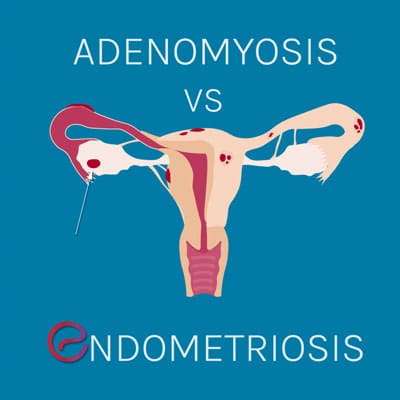Endometriosis vs. Adenomyosis

Endometriosis and adenomyosis are both gynecological disorders involving the inner lining of the uterus (the endometrium) growing somewhere other than its normal location. The symptoms of both conditions usually overlap and they often develop together.
However, endometriosis and adenomyosis are not the same conditions. Different approaches are necessary to both diagnose and treat them.
In endometriosis, the cells lining the inside of the uterus (endometrial cells) grow outside the uterus. This often occurs in the pelvic cavity, fallopian tubes, bladder, or bowels.
In adenomyosis, however, endometrial cells grow deep into the muscles of the uterus, but not past it.
In both cases, the endometrial tissue responds to female hormones by thickening and shedding with each cycle. However, they cannot leave the body like the normal endometrium, thus causing severe pain and in some cases, subfertility or infertility.
Symptoms of endometriosis vs adenomyosis
Common symptoms of both conditions include:
- painful periods and cramps (dysmenorrhea)
- heavy menstrual bleeding with clots (menorrhagia)
- pain during intercourse (dyspareunia)
- painful bowel movements
- numbness and pain in nerves (neuropathy)
- abdominal pain
- painful urination (dysuria)
The symptoms of endometriosis can persist throughout the monthly cycle and may even continue after menopause.
Symptoms of adenomyosis, on the other hand, usually only occur during menstrual periods. Due to the internal growth of endometrial tissue, the uterus in adenomyosis is often thick and large, which can affect implantation of pregnancy. Symptoms of adenomyosis often resolve after menopause. It is also possible that women with adenomyosis have no symptoms at all.
Diagnosis of endometriosis vs adenomyosis
There are non-invasive imaging techniques such as magnetic resonance imaging (MRI) and ultrasonography that may help diagnose both endometriosis and adenomyosis.
However, to reach a definite diagnosis of endometriosis, the gold standard approach is laparoscopic excision surgery and a biopsy during surgery.
In adenomyosis, only a biopsy of the uterus can definitely diagnose the disease. However, this typically requires the complete surgical removal of the uterus (hysterectomy).
Risk factors of endometriosis vs adenomyosis
Risk factors of endometriosis include a family history of the disease, early onset of menstruation (before age 11), short monthly cycles (of less than 27 days), and heavy periods lasting more than seven days.
For adenomyosis, risk factors include multiparity (history of multiple births), history of C-sections, history of dilatation and curettage (D&C), smoking, irregular menstrual cycles, and other gynecological conditions such as uterine fibroids and endometriosis.
How do both conditions affect fertility?
The exact relationship between endometriosis and fertility is not fully clear. Endometriosis may make becoming pregnant difficult depending on the stage of the disease. However, research shows that 60-70% of endometriosis patients can get pregnant naturally. Some complications associated with the disease such as a distorted pelvic anatomy, an altered immune system, and low egg quality may lead to infertility in 30-50% of women with the disease.
It is not fully clear whether adenomyosis can lead to infertility. However, research has shown that the condition leads to a 50% increased risk of miscarriage, almost 25% risk of premature delivery, and up to 12% risk of delayed fetal development.
Treatment
There is currently no cure for either endometriosis, and for adenomyosis, the only cure is removal of the uterus. However, doctors can manage both conditions using surgical and non-surgical approaches depending on the severity of symptoms
In case of endometriosis, laparoscopic deep excision surgery is the gold standard of treatment to remove endometrial lesions.
In the case of adenomyosis, the only way to completely treat the disease is hysterectomy. However, this should only be the last resort. For example, laparoscopic deep excisional adenomyosis surgery can be performed to prevent the uterus from being removed and facilitating future pregnancies. A surgical technique called the Osada procedure can also be performed. Here, the uterine wall is reconstructed after adenomyotic tissues are excised. This technique can reduce symptoms of dysmenorrhea and patients can go back to normal menstruation and deliver healthy babies.
Medical treatments exist as well that can help with symptoms, but will may not reverse the disease or slow the progress of disease in every patient. The first-line medical treatments are hormonal, either progesterone only-based medication (pills or hormonal IUD), or combined hormonal medication (both estrogen and progesterone). In certain cases, gonadotropin releasing hormone (GnRH) agonists or antagonists may be used as well.
For both endometriosis and adenomyosis, treatments should be tailored to each patient based on what they have tried in the past, what their symptoms are, and what their goals are in family planning.
Get a Second Opinion
Our endometriosis specialists are dedicated to providing patients with expert care. Whether you have been diagnosed or are looking to find a doctor, they are ready to help.Our office is located on 872 Fifth Avenue New York, NY 10065.
You may call us at (646) 960-3080 or have your case reviewed by clicking here.